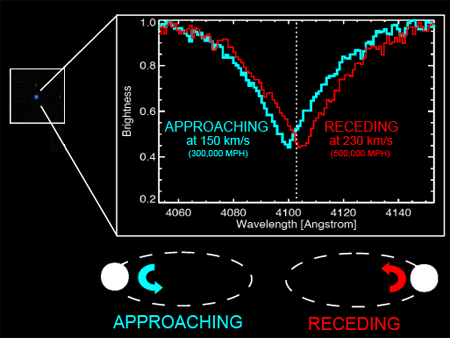A key part of the impact of SDSS has been the use of data by scientists outside of the project itself. Recent results from the public data released last year as Data Release 8 find that there are enough merging white dwarfs in our galaxy to explain the observed rate of Type Ia supernovae.
In a paper accepted today to the Astrophysical Journal Letters, “The Merger Rate of Binary White Dwarfs in the Galactic Disk”, astronomers Carles Badenes (University of Pittsburgh) and Dan Maoz (Tel-Aviv University) used the individual sub-exposures from SDSS spectra to analyze spectra of white dwarfs at different times to statistically determine the number of binary white dwarf systems in our region of the Milky Way. They found that the number of binary white dwarf systems is enough to explain the one Type Ia supernova every 100 years that occurs in a galaxy like our own.

(Image Credit: Carles Badenes and the SDSS-III team)
Some ordinary-looking faint blue star (left) is actually a pair of white dwarfs, stars nearly as massive as our sun but compressed by gravity to a density that is a million times higher. The analysis of SDSS data by Badenes and his team shows that white dwarf pairs are common enough that their collisions, induced by the emission of gravitational waves, can explain the important class of cosmic explosions known as “Type Ia supernovae.”
An SDSS spectrum usually detects light from just the brighter of the two white dwarfs. But we can learn of the presence of the fainter companion, and the future of both stars, from measuring multiple spectra of the star we can see. As the white dwarf orbits its unseen companion, it sometimes approaches us (blue in the drawing at the bottom) and sometimes recedes from us (red).
For more details see the SDSS-III press release
http://www.sdss3.org/press/20120227.fireworks.php
or the write-up in Ars Technica.
There is also a companion paper that gives more of the in-depth technical details:
“Characterizing the Galactic White Dwarf Binary Population with Sparsely Sampled Radial Velocity Data”
Dan Maoz, Carles Badenes, Steven J. Bickerton
http://arxiv.org/abs/1202.5467














